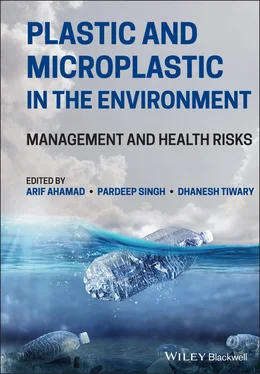Plastic and Microplastic in the Environment
Здесь есть возможность читать онлайн «Plastic and Microplastic in the Environment» — ознакомительный отрывок электронной книги совершенно бесплатно, а после прочтения отрывка купить полную версию. В некоторых случаях можно слушать аудио, скачать через торрент в формате fb2 и присутствует краткое содержание. Жанр: unrecognised, на английском языке. Описание произведения, (предисловие) а так же отзывы посетителей доступны на портале библиотеки ЛибКат.
- Название:Plastic and Microplastic in the Environment
- Автор:
- Жанр:
- Год:неизвестен
- ISBN:нет данных
- Рейтинг книги:5 / 5. Голосов: 1
-
Избранное:Добавить в избранное
- Отзывы:
-
Ваша оценка:
- 100
- 1
- 2
- 3
- 4
- 5
Plastic and Microplastic in the Environment: краткое содержание, описание и аннотация
Предлагаем к чтению аннотацию, описание, краткое содержание или предисловие (зависит от того, что написал сам автор книги «Plastic and Microplastic in the Environment»). Если вы не нашли необходимую информацию о книге — напишите в комментариях, мы постараемся отыскать её.
Thought-provoking discussions of the challenges posed by—and potential solutions to—plastic and microplastic pollution Plastic and Microplastic in the Environment: Management and Health Risks,
Plastic and Microplastic in the Environment
Plastic and Microplastic in the Environment: Management and Health Risks
Plastic and Microplastic in the Environment — читать онлайн ознакомительный отрывок
Ниже представлен текст книги, разбитый по страницам. Система сохранения места последней прочитанной страницы, позволяет с удобством читать онлайн бесплатно книгу «Plastic and Microplastic in the Environment», без необходимости каждый раз заново искать на чём Вы остановились. Поставьте закладку, и сможете в любой момент перейти на страницу, на которой закончили чтение.
Интервал:
Закладка:
1 Sources, Occurrence, and Analysis of Microplastics in Freshwater Environments: A Review
Anh Tuan Ta and Sandhya Babel
School of Biochemical Engineering and Technology, Sirindhorn International Institute of Technology, Thammasat University, Pathum Thani, Thailand
1.1 Introduction
Plastic products have benefited human life for one hundred years. Plastics are used in almost every sector including construction, packaging textiles, consumer products, transportation, electronics, industry, and medical applications. These products make our life more comfortable, convenient, and safe. The world plastics production in 2018 was about 360 million tonnes (PlasticsEurope 2018). However, due to poor management, about 10% of plastic wastes are discharged into aquatic environments (Cole et al. 2011). Recently, considerable attention is placed on the distribution of micro‐sized plastic particles, so‐called microplastics (MPs). The ubiquity of MPs has been widely documented in the marine environment, and their possible impact was investigated (Dris et al. 2018). MPs are frequently ingested by organisms, either from ingestion of other organisms containing MPs, or because they cannot distinguish MPs from prey (de Sá et al. 2015). This may cause physical harm for organisms including a disruption of the hormone balance or digestive system, reduced feeding, and impacting reproduction (Carr et al. 2012; Lusher et al. 2013). Another ecological risk relates to the interaction between MPs and toxic chemicals. The small plastic debris has a high surface area to volume ratio that can enhance the interaction of toxic chemicals onto their surface (de Sá et al. 2018). These chemicals may be carried by MPs over long distances and accumulate in organisms after being ingested (Bakir et al. 2016; Lee et al. 2014). Another potential risk is that MPs can be vectors of microorganisms that attach to their surfaces (Viršek et al. 2017). Human pathogens have been found to colonize on MP particles in marine environments (Foulon et al. 2016; Kirstein et al. 2016). However, the existence of MPs in aquatic environments is complex as they have different polymer types, morphologies, sizes, states of degradation, and contain different additives. Therefore, the evaluation of MPs toxicity is still hampered. Until now, most studies on MPs have been conducted on marine environments; while in contrast, the distribution of MPs in freshwater environments has been investigated less. To highlight this, a study by Blettler et al. (2018) found that 87% of MP studies were related to marine environments, while only 13% of the studies were on freshwater environments. A few studies reported that rivers can transport a huge amount of plastic and MPs into oceans; according to Schmidt et al. (2017), rivers contribute 88–95% of plastic wastes placed into the oceans. Methods for the identification of MPs have been developed by many researchers; however, these methods are not homogeneous and standardized, and this hampers the comparison between different studies (Li et al. 2018; Van Cauwenberghe et al. 2015).
This chapter reviews the current state of MPs in freshwater systems, and different techniques for sample collection, preparation, and analysis of MPs are summarized. Moreover, the potential sources, pathways, and occurrences of MPs into freshwater systems are discussed in the chapter.
1.2 Sources of Microplastic
MPs originate from various sources, but they are mainly sorted into primary and secondary sources. Primary MPs are produced in micro sizes, such as microbeads for personal care products and plastic resins. Secondary MPs are generated from the degradation of large plastics (Andrady 2011). Textile laundering facilities and sandblasting are other sources of MPs (Browne et al. 2011; Napper and Thompson 2016). The pollutants are washed down the drain along with wastewater and enters sewage systems, where they are too small to be removed by WWTPs and so end up in the river systems and finally in the oceans.
1.2.1 Primary Sources
1.2.1.1 Microplastics from Personal Care Products
Plastic materials have been utilized in the cosmetic industry for decades since the 1960s. The particles of plastic used in personal care products can be large enough to see with the naked eye (50–1000 μm), fine particles (lower μm‐range), or very fine particles (< 2.5 μm) (Leslie 2014). MPs used in the industry may be spherical or irregular morphology as shown in Figure 1.1(Godoy et al. 2019). MPs used as ingredients in cosmetic products include the |two main categories that are typically made from petroleum carbon sources: thermoplastics (e.g. polypropylene (), polyethylene (PE), polytetrafluoroethylene (Teflon), polystyrene (PS), polymethyl methacrylate (PMMA); and thermoset plastics (e.g. polyester, polyurethanes)) (Napper et al. 2015). According to Gouin et al. (2015), around 93% of the microbeads applied in cosmetics are PE, since their smoothness reduces redness and impact on the human skin compared to other polymers.

Figure 1.1 (a) Micrograph of a microbead found in Lantau Island, Hong Kong
Source: Cheung 2016, p. 02 / With permission from Elsevier. (b), (c) Scanning electron microscopy (SEM) of microbeads utilized in cosmetic products
Source: Napper 2015, p. 05 / With permission from Elsevier; Godoy 2019, p.06 / With permission from Elsevier.
1.2.1.2 Microplastics from Plastic Resins
Another major source of primary MPs are plastic resins (pellets or powders). The pellets or powder resin (≤ 0.5 mm) are generally cylindrical or disk shaped (Bergmann et al. 2015). These plastics are transported to factories for re‐melting and molding into a wide range of commercial plastic products. The plastics are released into the environment due to improper handling, such as accidents during transport or runoff from production processes.
1.2.2 Secondary Sources
1.2.2.1 Microplastics from Degradation of Plastic Debris
Large plastic debris in freshwater environments gradually degrades into smaller particles when exposed to some factors in the environments ( Figure 1.2). In the degradation of plastic, the average molecular weight of polymers is drastically reduced (Andrady 2011). The degradation can categorize as agents causing this process: biodegradation is an action of microorganisms; photodegradation is an action of light and sunlight; thermal degradation is the action of high temperatures; thermooxidative degradation is an oxidative breakdown at medium temperatures; hydrolysis degradation is a reaction with water. In the environment, UV radiation from sunlight is the major factor of plastic degradation, which speeds up the oxidative breakdown of polymers (Andrady et al. 1996). Polymers such as high‐density polyethylene (HDPE), low‐density polyethylene (LDPE), PP, and nylons are degraded mainly by the UV‐B radiation in sunlight as they are exposed to environments. As degradation is initiated, the thermooxidative process can continue without further exposure to UV radiation. The autocatalytic degradation may occur as long as the existence of oxygen in the system (Andrady 2011). During the degradation process, plastic wastes typically discolor, evolve surface features, and become weak and brittle, gradually. Other forces such as waves, wind, and human and animal activities can easily crack the embrittled plastics into small particles. The degradation and fragmentation of plastics is the major process for the formation of secondary MPs in aquatic environments (Kershaw 2015).
Читать дальшеИнтервал:
Закладка:
Похожие книги на «Plastic and Microplastic in the Environment»
Представляем Вашему вниманию похожие книги на «Plastic and Microplastic in the Environment» списком для выбора. Мы отобрали схожую по названию и смыслу литературу в надежде предоставить читателям больше вариантов отыскать новые, интересные, ещё непрочитанные произведения.
Обсуждение, отзывы о книге «Plastic and Microplastic in the Environment» и просто собственные мнения читателей. Оставьте ваши комментарии, напишите, что Вы думаете о произведении, его смысле или главных героях. Укажите что конкретно понравилось, а что нет, и почему Вы так считаете.












